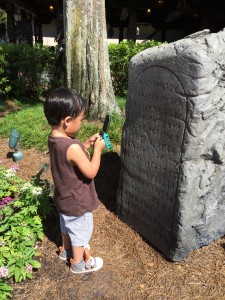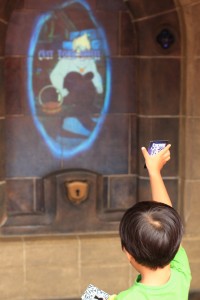My wife and I recently took our son to Walt Disney World in Orlando, Florida, to celebrate his fourth birthday. We figured he was just old enough to comprehend and enjoy the theme park offerings, just tall enough to ride the majority of the rides, and just cooperative enough to make the trip not entirely a nightmare. We took a weeklong vacation, staying at a nearby resort, and we snagged four-day park-hopper passes that gave us entry into all of the four Disney parks. As any parent who has been to a theme park with a young child probably knows, it is no easy feat. And I was prepared to endure four days of physical and mental stress with the express intent of ensuring my son’s enjoyment over any hope of getting any of my own.
I was pleasantly surprised.
I haven’t been to theme parks much in the last decade. I’ve lost my fondness for them. Most of my adolescent theme park experiences consisted of hours upon hours of line-waiting beneath a blinding noon-day sun, punctuated by all-too-brief bursts of death-defying thrill.
While the scorch of the sun hasn’t really changed over the years, I was glad to discover that Disney, in the meantime, has evolved its ideas of interactive and immersive theme park entertainment. The best of these ideas have culminated in what are basically family-friendly, short-form alternate reality games, in which park guests embark on interactive quests in service of a narrative themed around some specific Disney property.
Epcot touted the Phineas-&-Ferb-themed Agent P’s World Showcase Adventure. Opened to the public just last year (2012), it is a modern and more relevant re-skin of Kim Possible’s World Showcase Adventure, which was itself opened in 2009 and based on a now-defunct cartoon. In Agent P’s World Showcase Adventure, Epcot attendees could choose to embark on one of several missions around the world to help Perry (the cartoon’s lovable secret agent platypus) foil another of the evil Dr. Doofenshmirtz’s diabolical and comical plans. Players were given a cell phone that relayed mission objectives and allowed them to take part in the spycraft. In addition, animated segments would play out on the phone’s screen throughout the missions, showing how the hijinks of the player, Perry, and his host family all managed to intertwine in hilarious synchronicity, in typical Phineas & Ferb fashion.
 While there are seven different missions situated throughout Epcot’s World Showcase area, my family only had time to participate in three of them over the course of two visits to the park. Of the three, I was most impressed by the first scenario we played – Norway. It had the most variety of interaction. For one objective, hidden cameras took photos of us. For another, my son had to utter a secret passphrase to an actual ride attendant in exchange for a card with a secret code. For yet another objective, my son had to point the phone’s camera at a runic stone tablet, which proceeded to light up with hidden glyphs, much to the surprise of unwary onlookers.
While there are seven different missions situated throughout Epcot’s World Showcase area, my family only had time to participate in three of them over the course of two visits to the park. Of the three, I was most impressed by the first scenario we played – Norway. It had the most variety of interaction. For one objective, hidden cameras took photos of us. For another, my son had to utter a secret passphrase to an actual ride attendant in exchange for a card with a secret code. For yet another objective, my son had to point the phone’s camera at a runic stone tablet, which proceeded to light up with hidden glyphs, much to the surprise of unwary onlookers.
The Magic Kingdom park itself possessed two of its own interactive adventures. While each of the Agent P’s World Showcase Adventure scenarios were meant to be experienced within a short consecutive time frame (approximately half an hour), the Magic Kingdom’s adventures were more or less designed to be experienced at your own pace.
The newest of these adventures, unveiled just this year (2013), is A Pirate’s Adventure – Treasure of the Seven Seas, themed around Disney’s Pirates of the Caribbean. In it, players receive one of five maps, each overlaid with a number of symbols and clues to where those same symbols can be found engraved on unique objects throughout the Adventureland area of the park. Players are directed to the first symbol, following a pirate-themed quest to procure some legendary pirate artifact. Players swipe their park ticket over each engraved symbol to activate a narrative sequence, generally accompanied by bellowing voiceovers and animatronics, after which the next symbol for the journey would be revealed. On the first map (and the only one my family had time to play) entitled Heads You Lose, one of the waypoint symbols triggered a flurry of imaginary blow darts that actually impelled me and my son to duck and cover. It appears that the four subsequent maps continue to build on a central story, but I didn’t have the opportunity to explore it further.
 The second of the Magic Kingdom adventures (and arguably the most popular) is a gem by the name of Sorcerers of the Magic Kingdom. In this adventure, players are the titular sorcerers, recruited to help stop Hades and his henchmen (consisting of other assorted Disney villains) from gathering and assembling shards of the “Crystal of the Magic Kingdom.” Each team of players is given a map and an RFID “key” card that stores the team’s progress through the adventure. Much like the Pirate’s Adventure pattern of play, players swipe the key card over iconic bronze lock devices situated throughout the park (at locations marked with unique symbols on the map) in order to open portals. These portals consist of projected interactive videos that advance the story and pit the players against various enemies. To do battle, each individual player is also given a pack of collectible spell cards when they start their adventure. The spell cards are themed around a variety of Disney characters from different animated films. Each spell card summons its corresponding character to perform a unique attack. For example, Buzz Lightyear’s card summons him to shoot his wrist-mounted laser beam at an enemy. When required to cast spells during an open portal sequence, players simply hold out the spell card they wish to cast. After resolving the conflict at each portal, players are directed to the location of the next one.
The second of the Magic Kingdom adventures (and arguably the most popular) is a gem by the name of Sorcerers of the Magic Kingdom. In this adventure, players are the titular sorcerers, recruited to help stop Hades and his henchmen (consisting of other assorted Disney villains) from gathering and assembling shards of the “Crystal of the Magic Kingdom.” Each team of players is given a map and an RFID “key” card that stores the team’s progress through the adventure. Much like the Pirate’s Adventure pattern of play, players swipe the key card over iconic bronze lock devices situated throughout the park (at locations marked with unique symbols on the map) in order to open portals. These portals consist of projected interactive videos that advance the story and pit the players against various enemies. To do battle, each individual player is also given a pack of collectible spell cards when they start their adventure. The spell cards are themed around a variety of Disney characters from different animated films. Each spell card summons its corresponding character to perform a unique attack. For example, Buzz Lightyear’s card summons him to shoot his wrist-mounted laser beam at an enemy. When required to cast spells during an open portal sequence, players simply hold out the spell card they wish to cast. After resolving the conflict at each portal, players are directed to the location of the next one.
The entirety of the Sorcerers adventure consists of nine chapters, each of which is localized to one of four park areas. The subplot of each chapter revolves around stopping one of the unique Disney villains. While my family only had time to complete the first three chapters (defeating Cruella de Vil, Ratcliffe, and Ursula along the way), I’ve since discovered that there are actually two harder campaign difficulties that are unlocked after successive completions. The easiest difficulty – and the most accessible, family-friendly one – doesn’t require any kind of thought with regard to spellcasting and battles. Every spell always works in every situation. As a player progresses in difficulty, the enemies gain resistances and weaknesses to particular spell types, and battles begin to require multiple spells.
Needless to say, Sorcerers was a huge hit with my family. My son loved opening portals and casting spells. My wife and I loved the collectible cards and their uniquely animated effects. Visitors to the park are entitled to a new pack of cards each day, so we decided to pass through a second time. We even bought a supplementary conversion kit at the Main Street Emporium that turns the cards into a simple co-op boardgame, where players can construct custom decks to battle a randomly included Disney boss. And we were clearly not the only fans. It wasn’t uncommon to spy fully grown adults wielding Mage Wars style spellbooks of these cards – spellbooks! – brandishing entire pages in combat. My wife even went so far as to lurk on the corner of Main Street and hawk trades like a cardboard drug dealer.
And we all basically have one guy to thank for these immersive, participatory experiences – a Disney “Imagineer” by the name of Jonathan Ackley, whose illustrious credits include the Lucasarts adventure game The Curse of Monkey Island and the programmable LEGO Mindstorms series of toys.
Collectible game addiction aside, it’s hard for me to ignore the similarities between these “imagineered” adventure scenarios and geocaching. They’re both basically glorified games of hide-and-seek. But their common, underlying compulsion of play – the joy of discovery – primitive though it may be, works, as is evidenced by geocaching’s continuously growing popularity. It’s especially interesting to note how geocachers refer to onlookers as “muggles” – the magic-inept rabble of the Harry Potter world. There’s a parallel to be found there. Being cognizant of and capable of finding secrets hidden throughout the world does, indeed, feel magical. And Disney managed to bottle some of that magic.
But I Love Bees, these are not. There are still plenty of things that could be done to further deepen the experience without necessarily sacrificing that critical level of accessibility. I can imagine one sorcerer struggling against an iconic Disney villain, only to have another, more powerful one join the fray with rare protective or restorative magic; or a hidden switch at the end of a pirate adventure that, when activated, opened a hidden area of the park where other fellow pirate recruits gathered for an important meeting with Jack Sparrow to coordinate a choreographed attack on a Spanish fort (look, park-goer choreography isn’t that far-fetched); or an enormous Rube Goldberg device that required multiple secret agents working in tandem to destroy Dr. D’s latest invention of doom. I would really love to see those moments of spontaneous co-op among park-goers – after all, what could possibly leave a more magical and more lasting impression on a young mind than the forging of a friendship?
In any case, I really look forward to that day two decades from now when I return with my future grandchildren and see what kind of new things the Disney parks have in store.
